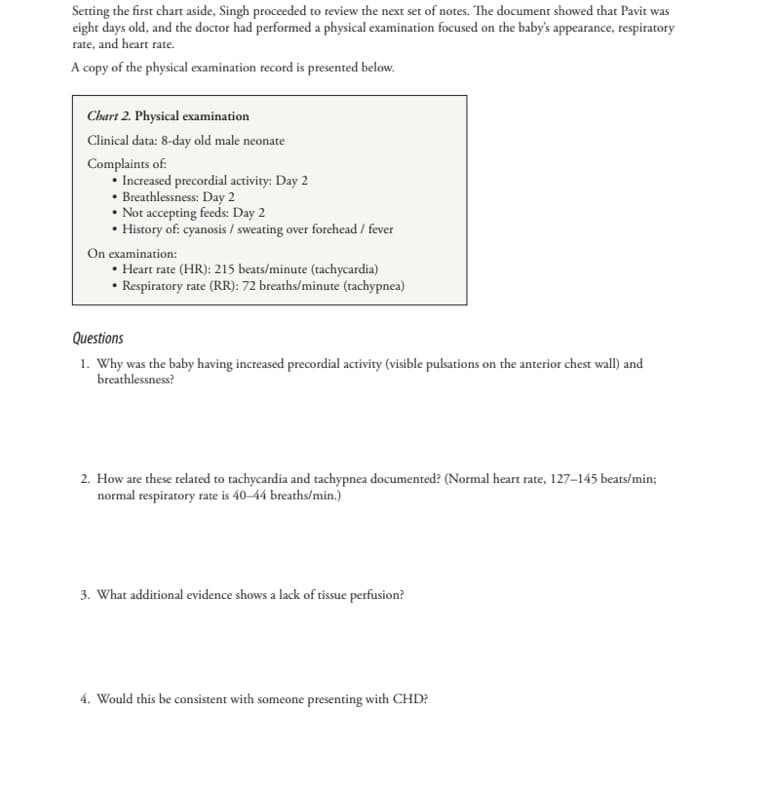Setting the first chart aside, Singh proceeded to review the next set of notes. The document showed that Pavit was eight days old, and the doctor had performed a physical examination focused on the baby's appearance, respiratory rate, and heart rate. A copy of the physical examination record is presented below. Chart 2. Physical examination Clinical data: 8-day old male neonate Complaints of: Increased precordial activity: Day 2 Breathlessness: Day 2 • Not accepting feeds: Day 2 History of: cyanosis/sweating over forehead / fever On examination: ⚫Heart rate (HR): 215 beats/minute (tachycardia) • Respiratory rate (RR): 72 breaths/minute (tachypnea) Questions 1. Why was the baby having increased precordial activity (visible pulsations on the anterior chest wall) and breathlessness? 2. How are these related to tachycardia and tachypnea documented? (Normal heart rate, 127-145 beats/min; normal respiratory rate is 40-44 breaths/min.) 3. What additional evidence shows a lack of tissue perfusion? 4. Would this be consistent with someone presenting with CHD?
Setting the first chart aside, Singh proceeded to review the next set of notes. The document showed that Pavit was eight days old, and the doctor had performed a physical examination focused on the baby's appearance, respiratory rate, and heart rate. A copy of the physical examination record is presented below. Chart 2. Physical examination Clinical data: 8-day old male neonate Complaints of: Increased precordial activity: Day 2 Breathlessness: Day 2 • Not accepting feeds: Day 2 History of: cyanosis/sweating over forehead / fever On examination: ⚫Heart rate (HR): 215 beats/minute (tachycardia) • Respiratory rate (RR): 72 breaths/minute (tachypnea) Questions 1. Why was the baby having increased precordial activity (visible pulsations on the anterior chest wall) and breathlessness? 2. How are these related to tachycardia and tachypnea documented? (Normal heart rate, 127-145 beats/min; normal respiratory rate is 40-44 breaths/min.) 3. What additional evidence shows a lack of tissue perfusion? 4. Would this be consistent with someone presenting with CHD?
Related questions
Question

Transcribed Image Text:Setting the first chart aside, Singh proceeded to review the next set of notes. The document showed that Pavit was
eight days old, and the doctor had performed a physical examination focused on the baby's appearance, respiratory
rate, and heart rate.
A copy of the physical examination record is presented below.
Chart 2. Physical examination
Clinical data: 8-day old male neonate
Complaints of:
Increased precordial activity: Day 2
Breathlessness: Day 2
• Not accepting feeds: Day 2
History of: cyanosis / sweating over forehead / fever
On examination:
⚫Heart rate (HR): 215 beats/minute (tachycardia)
• Respiratory rate (RR): 72 breaths/minute (tachypnea)
Questions
1. Why was the baby having increased precordial activity (visible pulsations on the anterior chest wall) and
breathlessness?
2. How are these related to tachycardia and tachypnea documented? (Normal heart rate, 127-145 beats/min;
normal respiratory rate is 40-44 breaths/min.)
3. What additional evidence shows a lack of tissue perfusion?
4. Would this be consistent with someone presenting with CHD?
Expert Solution
This question has been solved!
Explore an expertly crafted, step-by-step solution for a thorough understanding of key concepts.
This is a popular solution!
Step 1: Introducing the neonatal health challenges according to the situation given
VIEWStep 2: Explains the increased precordial activity of Pavit
VIEWStep 3: Explains the tachypnea and tachycardia given in the scenario
VIEWStep 4: Explains the tissue perfusion in the scenario
VIEWStep 5: Explains the possibilities for CHD in Pavit
VIEWSolution
VIEWTrending now
This is a popular solution!
Step by step
Solved in 6 steps
